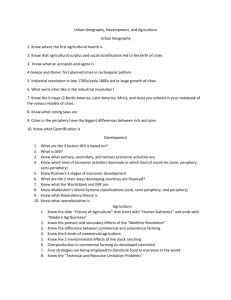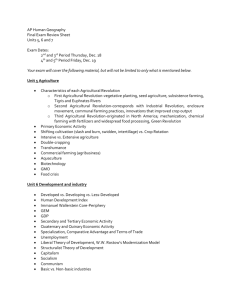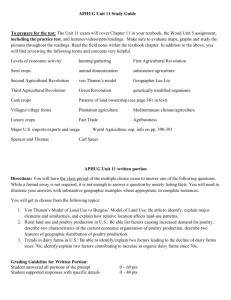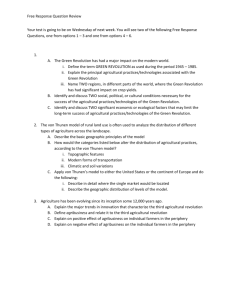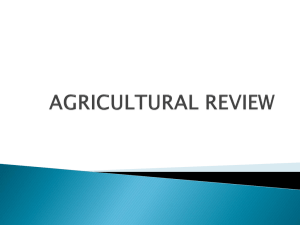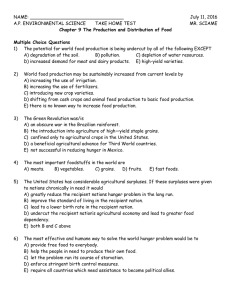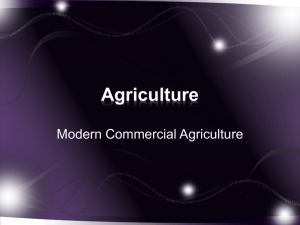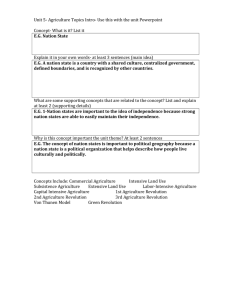File - Ms. Bohlin's Turf
advertisement
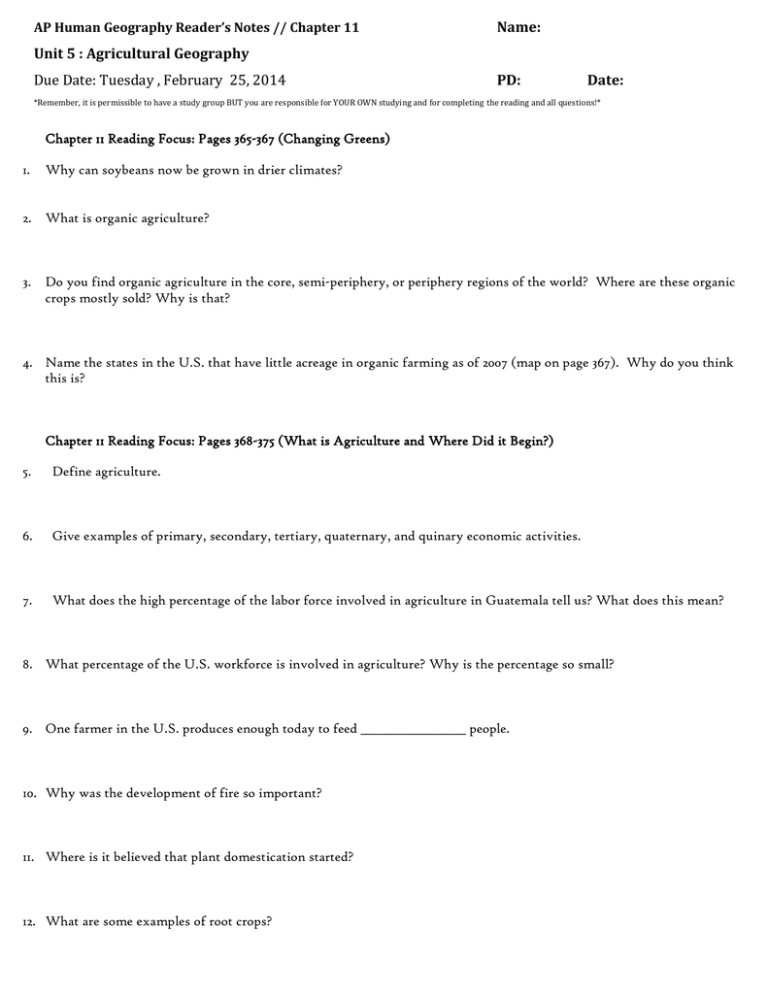
AP Human Geography Reader’s Notes // Chapter 11 Name: Unit 5 : Agricultural Geography Due Date: Tuesday , February 25, 2014 PD: Date: *Remember, it is permissible to have a study group BUT you are responsible for YOUR OWN studying and for completing the reading and all questions!* Chapter 11 Reading Focus: Pages 365-367 (Changing Greens) 1. Why can soybeans now be grown in drier climates? 2. What is organic agriculture? 3. Do you find organic agriculture in the core, semi-periphery, or periphery regions of the world? Where are these organic crops mostly sold? Why is that? 4. Name the states in the U.S. that have little acreage in organic farming as of 2007 (map on page 367). Why do you think this is? Chapter 11 Reading Focus: Pages 368-375 (What is Agriculture and Where Did it Begin?) 5. Define agriculture. 6. Give examples of primary, secondary, tertiary, quaternary, and quinary economic activities. 7. What does the high percentage of the labor force involved in agriculture in Guatemala tell us? What does this mean? 8. What percentage of the U.S. workforce is involved in agriculture? Why is the percentage so small? 9. One farmer in the U.S. produces enough today to feed ___________________ people. 10. Why was the development of fire so important? 11. Where is it believed that plant domestication started? 12. What are some examples of root crops? 13. Why is the planting of seed crops a more complex process than root crops? 14. What did settlement populations need to order to increase the size of settlements? 15. Briefly describe the process of animal domestication. (about when, where, how, what kinds of animals were domesticated where) 16. Describe subsistence farming. Where in the world is this found? 17. Explain shifting cultivation. Make sure to tell where this may be used in the world. 18. Explain slash-and-burn agriculture. Chapter 11 Reading Focus: Pages 375-381 (How did Agriculture Change with Industrialization?) 19. Why did a Second Agricultural Revolution have to take place? (Think of numbers of people who would be working in factories instead of farming.) 20. Name the British law that played a part in the Second Agricultural Revolution. What did this law encourage? 21. Overall, what did the increases in farm production make possible? 22. When agriculture is based on producing food for people who live in towns or cities, a geography emerges based on _______________________ and cost of ________________________________. 23. Explain how Johann Heinrich von Thunen developed his model of spatial distribution of agricultural activities. 24. Give an example of von Thunen’s Model on a large scale. 25. When and where did the Green Revolution begin? 26. What were the goals of the Green Revolution? 27. What continent has not had as much success with the Green Revolution? Why? 28. What are some negatives about the Green Revolution? 29. What size is the average family farm in China? (In the U.S. it’s 441 acres.) 30. What are GMOs? 31. What agricultural changes have taken place n Gambia in recent years? Chapter 11 Reading Focus: Pages 381-386 (What Imprint does Agriculture Make on the Cultural Landscape?) 32. What is a cadastral system? 33. What is the prevailing survey system in the United States? Why is this? ***The rectangular survey system has its roots in the Homestead Act that gave 160 acres of land homesteaders during American westward. 34. The basic unit of this system is __________ square mile. 35. Describe the metes and bounds survey system. 36. Explain how the system of primogeniture worked? 37. What percentage of the population in India works in farming? 38. Describe the dispersed settlement pattern. Where is this used? 39. Describe the nucleated settlement pattern. Where is this used? 40. What is meant by the “functional differentiation of buildings” in villages? Chapter 11 Reading Focus: Pages 386-401 (What is the Global Pattern of Agriculture and Agribusiness?) 41. What led to the establishment of plantations? 42. Explain the development of commercial agriculture. 43. What is monoculture? 44. What does Koppen’s climate classification system do? (How does it classify the world’s climates?) 45. What are climatic regions? 46. How have American and European multinational corporations influence the development of plantation agriculture? 47. What competes with cotton today? 48. What is the purpose of US government farm subsidies? 49. Why do farmers in the periphery often plant crops that can be turned into illegal drugs? 50. What part of the world consumes the most illegal drugs? (core, semi-periphery, periphery) Why is this? 51. What are luxury crops? Provide a few original examples. 52. Who buys half of all coffee sold in the world today? Why do you think this is? 53. Describe coffee production in Latin America today. 54. Why are more consumers demanding fair trade coffee? 55. What are the environmental concerns about large commercial crop farming? 56. What damage livestock herding can do? 57. What is causing the loss of productive farmland in the U.S.?
